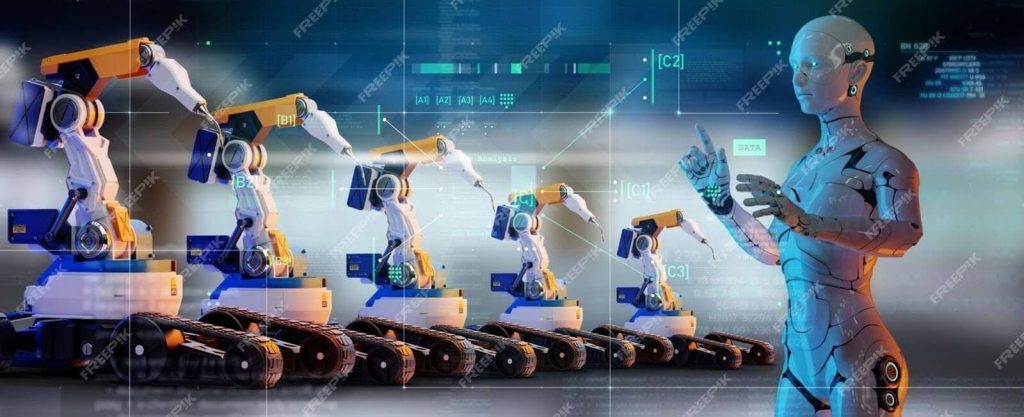Curious about what comes after robotics automation services? The next big thing is Hyperautomation. It goes beyond simply accelerating tasks. It represents an intelligent approach that merges robotics automation services with artificial intelligence (AI) and other technological advancements.
In addition to handling monotonous jobs, it also automates intricate procedures to enhance productivity. It’s not just about handling repetitive jobs; it also tackles more advanced tasks that used to need humans in traditional automation. Hyperautomation’s goal is to improve how well things get done, making machines capable of doing jobs that were once only for people. Let’s explore how Hyperautomation will revolutionize work, enhancing its speed, intelligence, and efficiency for businesses.
Benefits of Hyperautomation for the Workplace of Future
By utilizing cutting-edge technologies and automating tedious and repetitive processes, human workers may concentrate on more intricate and significant projects. This results in higher output, fewer mistakes, and better decision-making skills.
Furthermore, because Hyperautomation is flexible enough to change and grow with the demands of the business, it may help enterprises scale their operations with ease.
How Robotics Automation Services is Revolutionizing Industries
Robotics automation services has been a game-changer across various sectors, transforming industries and streamlining operations.
Manufacturing and Production
Industries like manufacturing have seen significant enhancements through automation. Machines and robots now handle various tasks, significantly increasing production rates and maintaining consistent quality. In this sector, automation has brought forth advancements in precision, enabling the production of higher-quality goods within shorter timeframes. With automated processes, manufacturing units can scale their output and reduce errors, contributing to increased efficiency.
Medical Services and Healthcare
Medical personnel can now spend more time providing patient care because automation has reduced manual workloads and administrative duties in the healthcare industry. Automation has expedited procedures like data input, inventory management, and appointment scheduling, resulting in more precise and timely services. Automation also helps to speed up the drug discovery process, which could result in advancements in medical research and development.
Chatbots and virtual assistants have been introduced by Customer Service and Support Automation, revolutionizing customer service. These automated systems answer common questions, give prompt service, and assist users with simple troubleshooting. This more efficient method has drastically cut down on wait times, providing clients with quicker resolutions and raising their level of satisfaction all around. Furthermore, automation has enabled companies to manage high volumes of customer queries simultaneously, improving service accessibility.
Finance and Banking
The finance industry has embraced automation to streamline various processes, including transaction processing, fraud detection, and data analysis. Automated systems ensure faster and more accurate financial transactions while identifying potential fraudulent activities swiftly.
Is Cloud Warehouse Automation a Good Fit for Your Organization?
Enhance your chances with Cloud Warehouse Automation to know whether it is a good fit for your business or not.
Additionally, automation facilitates better risk management and decision-making by analyzing large volumes of financial data in real time. This technology has optimized banking operations and improved financial services’ reliability and security.
Supply Chain Administration
Automation has transformed logistics and supply chain operations by improving warehouse management, inventory tracking, and order fulfilment. Robotics automation services and automated systems handle inventory storage and retrieval efficiently, reducing errors and expediting order processing. Moreover, automated tools provide real-time tracking and monitoring, enhancing visibility across the supply chain and ensuring timely deliveries.
The Impact of Hyperautomation on Job Roles
1) Shifting Job Roles
With Hyperautomation, the traditional perception of job roles is transforming. Some regular and recurrent tasks are being automated, allowing employees to concentrate on higher-value, strategic, and creative aspects of their jobs. While certain job functions may be automated, the need for human oversight and decision-making in managing and optimizing automated processes remains critical.
2) Creation of New Roles
As technology advances, the demand for new skill sets is emerging. Jobs that require a blend of technical expertise and human judgment are on the rise. Roles involving the supervision, maintenance, and enhancement of automated systems are becoming increasingly important. Employees will need to adapt and learn new skills to effectively collaborate with automated technologies.
3) Evolving Skill Sets
The skills required for job roles are evolving in response to Hyperautomation. While technical competencies in handling automation tools are essential, soft skills such as critical thinking, problem-solving, adaptability, and effective communication are gaining prominence. Employees need to possess a combination of technical prowess and interpersonal skills to collaborate effectively with automated systems.
Cooperation between Robots and People
Humans and robots will work together more in the workforce of the future. Employment positions will necessitate workers to collaborate with automated systems, utilising the advantages of both technology and human resources. While automated systems take care of monotonous work, humans will offer their creativity, emotional intelligence, and cognitive skills.
1) Shifting Employment Markets
Hyperautomation is changing the nature of the labor economy. New roles will inevitably arise, and although some functions may become outdated, others will not, calling for a workforce that can keep up with technology improvements. The need for people who can collaborate well with automated systems will only grow.
2) Competencies needed in the hyper-automated age
People with specialized skills are becoming more and more in demand as Hyperautomation develops. It is necessary to possess technical proficiency in fields like artificial intelligence, machine learning, data analysis, and process automation. Strong critical thinking, problem-solving, and communication skills are also becoming more and more important as workers must work well with automated systems. In this quickly changing environment, the ability to adapt to new technology and participate in ongoing learning will also be essential.
Hyperautomation’s ethical implications
Hyperautomation has many advantages, but it also poses moral questions. Addressing the potential loss of jobs due to automation is crucial. Automation must be implemented by businesses while upholding the rights of employees and offering assistance to individuals whose responsibilities are altered. Furthermore, issues with security, privacy, and biased algorithms require careful consideration. To ensure that Hyperautomation technologies are used responsibly and fairly, ethical frameworks and rules must be established.
Implementing Hyperautomation presents challenges
Although advantageous, implementing Hyperautomation presents several obstacles that businesses must overcome. These include:
Integration of Diverse Technologies and Systems
Integrating various systems and technologies is one of the main challenges. Organizations often operate on multiple platforms and software, making the integration complex and time-consuming. A critical component of implementation is making sure that various automation tools are compatible and work seamlessly with current systems.
Employee Reluctance to Change
Employee opposition to change presents another difficulty. When automation becomes more prevalent, employees may need to adjust to new procedures or worry about their job security. Workers used to manual processes could find it difficult to accept automated technologies, therefore strong change management techniques and comprehensive training plans are needed to ensure adoption goes smoothly.
The initial outlay and the ROI (return on investment)
The initial cost of putting Hyperautomation into practice can be high. Businesses need to weigh the possible return on investment against the associated expenses with great caution. Determining the financial advantages and projecting the duration needed for the system to show observable returns becomes essential for making decisions and winning over stakeholders.
Data Privacy, Security, and Algorithmic Bias
Addressing concerns related to data privacy, security, and algorithmic bias is paramount. With automated systems handling vast amounts of data, ensuring the privacy and security of sensitive information becomes a critical challenge. Organizations need robust measures to safeguard data against unauthorized access or breaches. Additionally, algorithmic biases need to be mitigated to ensure fair and unbiased decision-making by automated systems.
Training and Change Management
Equipping the workforce with the necessary skills to operate in a hyper-automated environment poses a challenge. Employees require training and upskilling to effectively utilize and collaborate with automated systems. Implementing comprehensive change management programs becomes essential to create awareness, drive acceptance, and empower employees to embrace and adapt to the new technological landscape.
Future predictions for Hyperautomation
The future of Hyperautomation holds immense potential. As technologies continue to advance, hyperautomated systems will become more intelligent and adaptive. The scope of tasks that can be automated will expand, enabling organizations to achieve even greater efficiency gains.
Hyperautomation is set to reshape entire industries and generate fresh job opportunities, calling for a workforce capable of efficient collaboration with automated systems. Nonetheless, maintaining a balance between robotics automation services and human engagement is crucial to ensure that technology acts as a tool to amplify human abilities rather than completely substituting them.
Read More:
- Revving Up Future: Harnessing AI To Drive Autonomous VehiclesThe change of self-driving cars has been made possible with AI. Let us know the main features of AI to drive autonomous vehicles.



